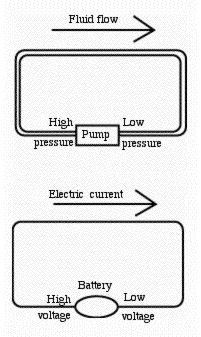
Using a pump we can push water through a pipe around a closed circuit (top drawing). The rate at which it flows past any point in the pipe--measured in gallons (or liters) per second--depends on the pressure produced by the pump (measured in pounds per square inch, or kilograms per square centimeter). More accurately, it depends on the pressure difference between the entrance to the pipe (left) and the exit from the pipe (right).
The greater the pressure difference, the greater the flow. In addition, given a certain pressure difference, a fatter pipe will carry more water, and a longer one will resist the flow and carry less.
All this mirrors exactly the behavior of the electric fluid.
No pipes here, though: electricity in our homes and appliances usually flows in metal wires, most often of copper. Electrons in a metal can jump from atom to atom, and that way carry negative charge around the circuit.
Like a fluid, they are driven by a kind of electric pressure, known as voltage, because it is measured in units known as volts, named after the Italian scientist Alessandro Volta. An electric battery produces (by a chemical process) a voltage difference V between its two ends, and therefore acts like a pump (bottom drawing).
The electric current I flows from high voltage to low voltage and is measured in units known as Amperes, named for André-Marie Ampere whom we met in section #2. And as with water, we expect that if we increase the driving voltage V, the driven current I will also increase. In fact, the two are pretty much proportional: double the voltage, and you get double the current. That relation is known as Ohm's Law, after Georg Ohm who first formulated it.
Ohm's law (with some extra details concerning the length and thickness of the wire) is usually among the first things taught in electricity classes, and many students therefore view it as one of the fundamental laws of electricity. It isn't. It holds quite well for metal wires, but as will be shown in section #7a, it fails badly in fluorescent tubes--while in space currents exist which flow without any voltage driving them (section #10a).
| 